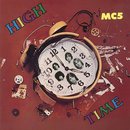The MC5 is an American rock band first formed in Lincoln Park, Michigan. They are most noted as forerunners of punk rock, as well as an important early hard rock band in America. The band was originally active from 1964 until 1972, before reforming in 2003 with punk singer Handsome Dick Manitoba, of The Dictators, as its new vocalist. The original band line-up consisted of vocalist Rob Tyner, guitarists Wayne Kramer and Fred "Sonic" Smith, bassist Michael Davis, and drummer Dennis Thompson.















"Crystallizing the counterculture movement at its most volatile and threatening",[1] according to Allmusic critic Stephen Thomas Erlewine, the MC5's far left political ties and anti-establishment lyrics and music positioned them as emerging innovators of the punk movement. Their loud, energetic style of back-to-basics rock 'n' roll included elements of garage rock, hard rock, blues-rock, and psychedelic rock.
The MC5 had a promising beginning which earned them a cover appearance on Rolling Stone magazine in 1969 even before their debut album was released.[2] They developed a reputation for energetic and polemical live performances, one of which was recorded as their 1969 debut album Kick Out The Jams. Their initial run was ultimately short-lived, though within just a few years of their dissolution in 1972, the MC5 were often cited as one of the most important American hard rock groups of their era.[3] Their three albums are regarded by many as classics, and their song "Kick Out the Jams" is widely covered.
Tyner died of a heart attack in late 1991, aged 46. Smith also died of a heart attack, in 1994, at the age of 45. Nine years later, Kramer, Davis and Thompson decided to reform the MC5, and this reformed line-up currently performs live.
First incarnation
Early years
The origins of the MC5 can be traced to the friendship between guitarists Wayne Kramer and Fred Smith. Friends since their teen years, they were both fans of R&B music, blues, Chuck Berry, Dick Dale, the Ventures, and what would later be called garage rock: they adored any music with speed, energy and a rebellious attitude. Each guitarist/singer formed and led a rock group (Smith's Vibratones and Kramer's Bounty Hunters). As members of both groups left for college or straight jobs, the most committed members eventually united (under Kramer's leadership and the Headhunters name) with Michael Fraser on vocals/bass and Grant Palmer on drums, and were popular and successful enough in and around Detroit that the musicians were able to quit their day jobs and make a living from the group.
Kramer felt they needed a manager, which led him to Rob Derminer, a few years older than the others, and deeply involved in Detroit's hipster and left-wing political scenes. Derminer originally auditioned as a bass guitarist, though they quickly realized that his talents could be better used as a lead singer: though not conventionally attractive and rather paunchy by traditional frontman standards, he nonetheless had a commanding stage presence, and a booming baritone voice that evidenced his abiding love of American soul and gospel music. Derminer renamed himself Rob Tyner (after Coltrane's pianist McCoy Tyner). Tyner also invented their new name, The MC5: it reflected their Detroit roots (it was short for "Motor City Five'), was vaguely reminiscent of a sports car name (like the GTO), and echoed the Dave Clark Five, at the peak of their popularity in 1964–1965. In some ways the group was similar to other garage bands of the period, composing soon-to-be historic workouts such as "Black to Comm" during their mid-teens in the basement of the home of Kramer's mother.
The music also reflected Smith and Kramer's increasing interest in free jazz -- the guitarists were inspired by the likes of Albert Ayler, Archie Shepp, Sun Ra and late period John Coltrane, and tried to imitate the ecstatic sounds of the squealing, high-pitched saxophonists they adored. The MC5 even later opened for a few U.S. midwest shows for Sun Ra, whose influence is obvious in "Starship". Kramer and Smith were also deeply inspired by Sonny Sharrock, one of the few electric guitarists working in free jazz, and they eventually developed a unique interlocking style that was like little heard before: Kramer's solos often used a heavy, irregular vibrato, while Smith's rhythms contained an uncommon explosive energy, including patterns that conveyed great excitement, as evidenced in "Black to Comm" and many other songs.
Success in Detroit
Playing almost nightly any place they could in and around Detroit, the MC5 quickly earned a reputation for their high-energy live performances and had a sizeable local following, regularly selling out to audiences of 1000 or more. Contemporary rock writer Robert Bixby stated that the sound of the MC5 was like "a catastrophic force of nature the band was barely able to control," while Don McLeese notes that fans compared the aftermath of an MC5 performance to the delirious exhaustion experienced after "a street rumble or an orgy." (McLeese, 57)
Their debut single was released by Trans-Love Energies in early 1968, comprising two original songs: "Borderline" and "Looking at You." The first pressing sold out in a few weeks, and by the year's end, had gone through more pressings totaling several thousand copies.
That summer, MC5 toured the U.S. east coast, which generated an enormous response, with the group often overshadowing the more famous acts they opened up for: McLeese writes that when opening for Big Brother and the Holding Company audiences regularly demanded multiple encores of the MC5, and at a memorable series of concerts, Cream — one of the leading hard rock groups of the era — "left the stage vanquished" by the Detroit upstarts. (McLeese, 65) This same east coast tour led to the rapturous aforementioned Rolling Stone cover story that praised the MC5 with nearly evangelistic zeal, and also to an association with the radical group Up Against the Wall Motherfuckers.
The MC5 became the leading band in a burgeoning hard rock scene, serving as mentors to fellow South-Eastern Michigan bands The Stooges and Up, and major record labels expressed an interest in the group. As related in the notes for reissued editions of the Stooges' debut album, Danny Fields of Elektra Records came to Detroit to see the MC5. At Kramer's recommendation, he went to see the Stooges. Fields was so impressed that he ended up offering contracts to both bands in September 1968. They were the first hard rock groups signed to the fledgling Elektra.
Radical political affiliations
According to Kramer, the MC5 of this period was politically influenced by the Marxism/Maoism of the Black Panther Party and Fred Hampton.[4] Black Panther Party founder Huey P. Newton prompted John Sinclair to found the White Panthers, a militant leftist organization of white people working to assist the Black Panthers. Shortly after, Sinclair was arrested for possession of illegal narcotics.
Under the "guidance" of John Sinclair (who dubbed his enterprise "Trans-Love Energies" and refused to be categorized as a traditional manager), the MC5 were soon involved in left-wing politics: Sinclair was active with the White Panther Party and Fifth Estate. In their early career, the MC5 had a politically provocative stage show: they would appear onstage toting unloaded rifles, and at the climax of the performance, an unseen "sniper" would shoot down Tyner. The band members were also all using the drugs LSD and marijuana, though not all group members agreed with Sinclair's politics, as Thompson would later reveal in a 2000 interview for an article published in Goldmine magazine.[citation needed]
The band generated political controversy by performing before the outbreak of violent protests at the 1968 Democratic National Convention in Chicago. The group's appearance at the convention is also notable for their lengthy performance: in an interview featured in the documentary Get Up, Stand Up, Kramer reported that while many musicians were scheduled to perform at a day-long concert, only the MC5 initially appeared. The MC5 played for over eight hours straight; of the other scheduled performers, Kramer stated in Get Up, Stand Up that only Neil Young actually arrived, though due to the chaos at the convention, Young didn't perform. Dennis Thompson asserted years later that "Country Joe" McDonald (Country Joe and the Fish) was also present at the scene (Thompson, 2000). Other performers at the convention included the protest folk singer Phil Ochs.[5]
Recordings
Kick out the Jams
The MC5 earned national attention with their first album, Kick Out the Jams, recorded live on October 30 and 31, 1968 at Detroit's Grande Ballroom. A live debut was all but unheard of in 1968 (and is still rare today), but Elektra executives Jac Holzman and Bruce Botnick recognized that the MC5 were at their best when playing for a receptive audience. The first song, a version of the obscure Ted Taylor R&B song "Ramblin' Rose," featured a ragged falsetto lead vocal from Kramer before Tyner joined the group onstage. Containing such songs as the proto-punk classics "Kick Out the Jams" and "Rama Lama Fa Fa Fa", the spaced-out "Starship" (co-credited to Sun Ra because the lyrics were partly cribbed from one of Ra's poems), and an extended cover of John Lee Hooker's "Motor City is Burning" wherein Tyner praises the role of Black Panther snipers during the Detroit Insurrection of 1967. The album is generally regarded as one of the best live rock and roll records: critic Mark Deming writes that the gleefully lusty Kick "is one of the most powerfully energetic live albums ever made ... this is an album that refuses to be played quietly.[6]
The album caused some controversy due to the title track's rallying cry of "Kick out the jams, motherfuckers!" (according to Kramer, the band recorded this as "Kick out the jams, brothers and sisters